This weekend’s FAWSL fixtures brought us the final matchup between this season’s top three sides. Manchester City Women travelled to London to face Emma Hayes’ Chelsea Women side. Both sides have aspirations of ending the campaign with a league title, which increases the impetus on this match.
Each side has found some very good form in recent weeks. Manchester City Women have been running rampant against some of the smaller sides in the league, with some new tactics resulting from injury issues. Chelsea Women have continued from strength to strength this season. Only dropping points to Brighton and Hove Albion in the second match of the season, they have gone on to earn impressive victories over Arsenal and Manchester United.
In this tactical analysis, we will look at the tactics Hayes used to come away with the 2-1 win over Nick Cushing’s Manchester City Women’s side. This game went back and forth for the majority of the match before Chelsea Women’s pressure paid off, scoring two goals to seal the win after going down. This analysis will take a look at the specific tactics that proved trumps on the day.
Lineups
Chelsea Women (4-1-4-1): Berger; Mjelde, Bright, Eriksson, Andersson; Ingle; Cuthbert, Bachmann, Ji, Reiten; England
Manchester City Women (4-3-3): Roebuck; Beckie, Houghton, Bonner, Stokes; Walsh, Weir, Scott; Wullaert, White, Hemp
Chelsea Women set up in the shape that proved successful against Manchester United Women two weeks ago. Fran Kirby missed out on a place in the squad through injury, but this was the only notable absentee. As we will discuss later in this piece, Chelsea used some different formations in-game to defend against City.
Cushing kept his team the same as in previous weeks. Janine Beckie continues at right-back in the absence of Aoife Mannion. Tessa Wullaert began on the right side, but during the match, she was given the freedom to roam around the pitch in support of Ellen White up top. Caroline Weir occupied a deep position closer to Kiera Walsh to add defensive stability for this match.
Chelsea Women’s quick start
From the first whistle, Chelsea looked to press Manchester City high up the pitch. While they initially lined up in a 4-1-4-1, in their initial structure was a 4-4-2. Using this, Ramona Bachmann was brought forward to play in support of England upfront. Using this two-striker tactic, Hayes tasked her side with restricting City’s midfield from receiving passes from their centre-halves. As one of Bethany England or Bachmann went to press the ball, the other would look to make sure that there were no central passing lanes to find. They specifically marked Kiera Walsh in this dynamic, as they were well aware of her ability to cause danger from her deep playmaker position.
City were then forced to look for wide options, which had a ripple effect higher up the pitch. Stokes and Beckie were both forced to hold deeper positions than they normally do. This kept them from having the same attacking effect on the match as they normally produce. Their positioning away from the players higher up the pitch meant that once they received possession in these deeper areas, they could find forward options many times.
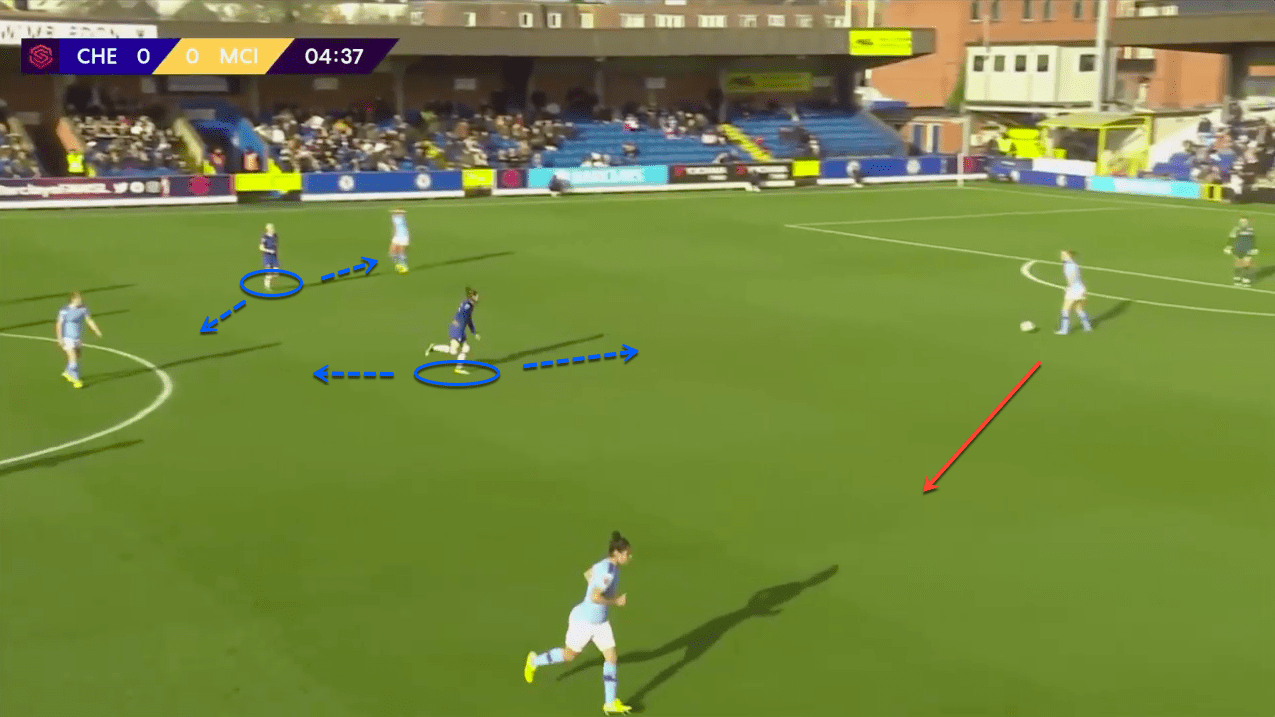
Above you can see an example of this structure set up by Chelsea. When Bonner receives possession, England positions herself to be able to press Steph Houghton if a pass is made there, or step inside if a pass is made into the midfield. Bachmann directly blocks the passing lane into Walsh. Demi Stokes recognises this and drifts wide to allow for an outlet. Chelsea Women delay their pressing in this area to encourage this pass. In the image below, you can see that Gemma Bonner has made the pass into Stokes. As soon as this pass is made, Erin Cuthbert jumps forward pressing Stokes. The press resulted in the away side losing possession in their defensive half.
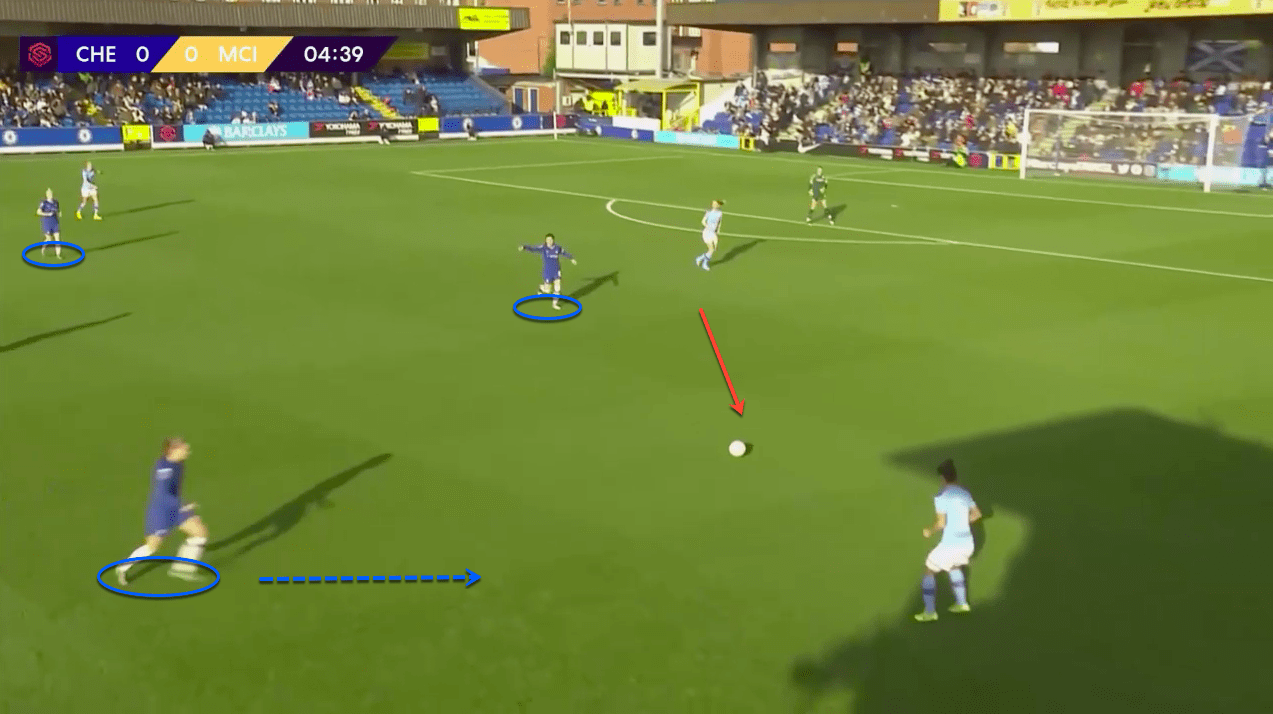
Chelsea were able to win possession back in dangerous areas on numerous occasions, but could not capitalise on the chances they were able to create. Below you can see an example of Haye’s side pressing City into a turnover. This represents a dangerous area for City, as they are attempting to push numbers forward to get a grasp on the match themselves. Chelsea break quickly and through some intricate play find England in a one-v-one on the right. She beats her defender only to be thwarted by Roebuck in goal. This opportunity represented the first of many Chelsea would get in the remainder of the match.
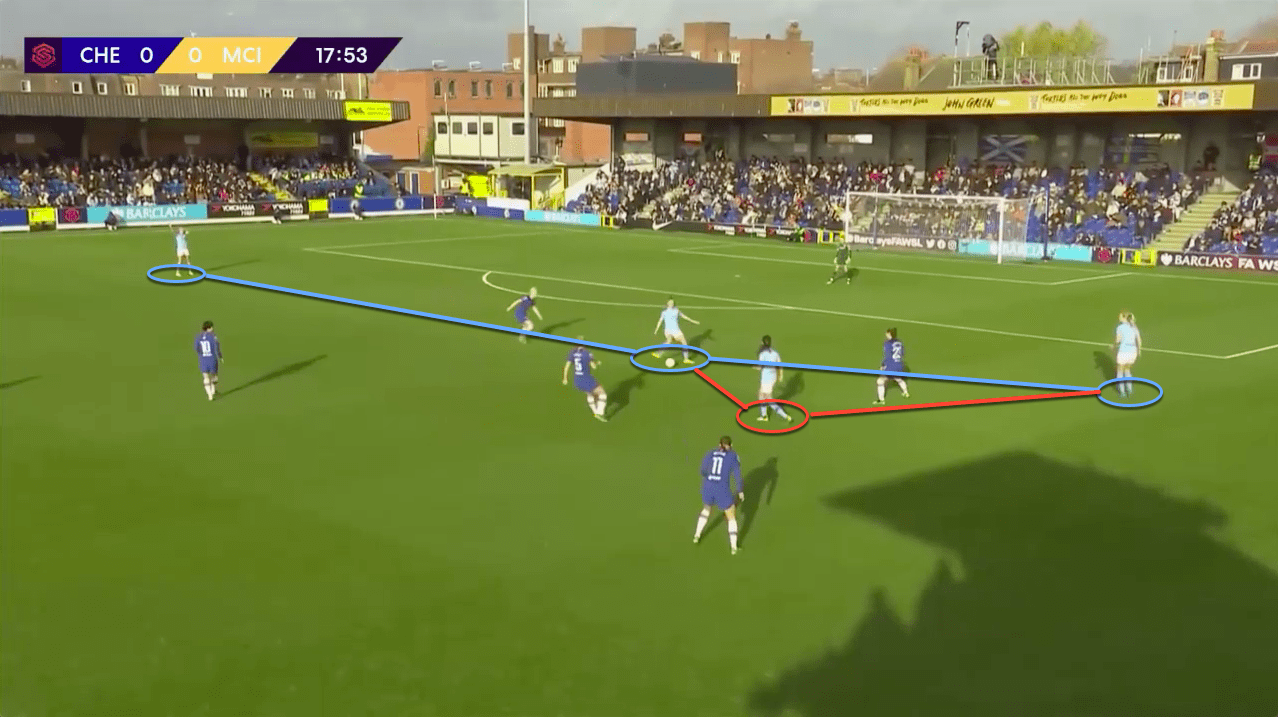
To bypass this press, City had to alter their structure. Walsh began to take up deeper positions between City’s two centre-halves. This created a 3v2 situation in this area of the pitch. Weir then acted as a third-man to make quick passes off of to move around the Chelsea forwards. Using this tactic, Manchester City Women gained the ability to penetrate Chelsea and hold possession higher up the pitch.
Manchester City Women’s attacking alterations
During the first-half, City were alarmingly quiet. This is not the first time, however, this has happened. Cushing has rued his side’s inability to generate attacking chances in a host of matches this season. Looking at this match, in particular, there were multiple reasons for this. As we spoke on above, City struggled to get around Chelsea’s press. Higher up the pitch, their attacking players seemed disjointed. Hemp was left isolated on the left side. Stokes deeper position due to Beckie’s inclusion at right-back in recent weeks has taken away from her support when breaking down defences. Wullaert spent most of her time down the right side of the pitch, drifting into the centre in an attempt to link White with the rest of the squad. However, the Chelsea centre-halves marshalled these two extremely well.
Changes were needed in the second half. To break through this Chelsea defence, Cushing moved Wullaert even further away from her initial position in the side. She drifted in the space on the left side of the pitch, from anywhere between next to White again on this side and a left-wing standing on the touchline.
Here, her goal was to combine with Hemp. Manchester City Women began looking to overload the left side of their attack in an attempt to break down this stubborn Chelsea defensive block.
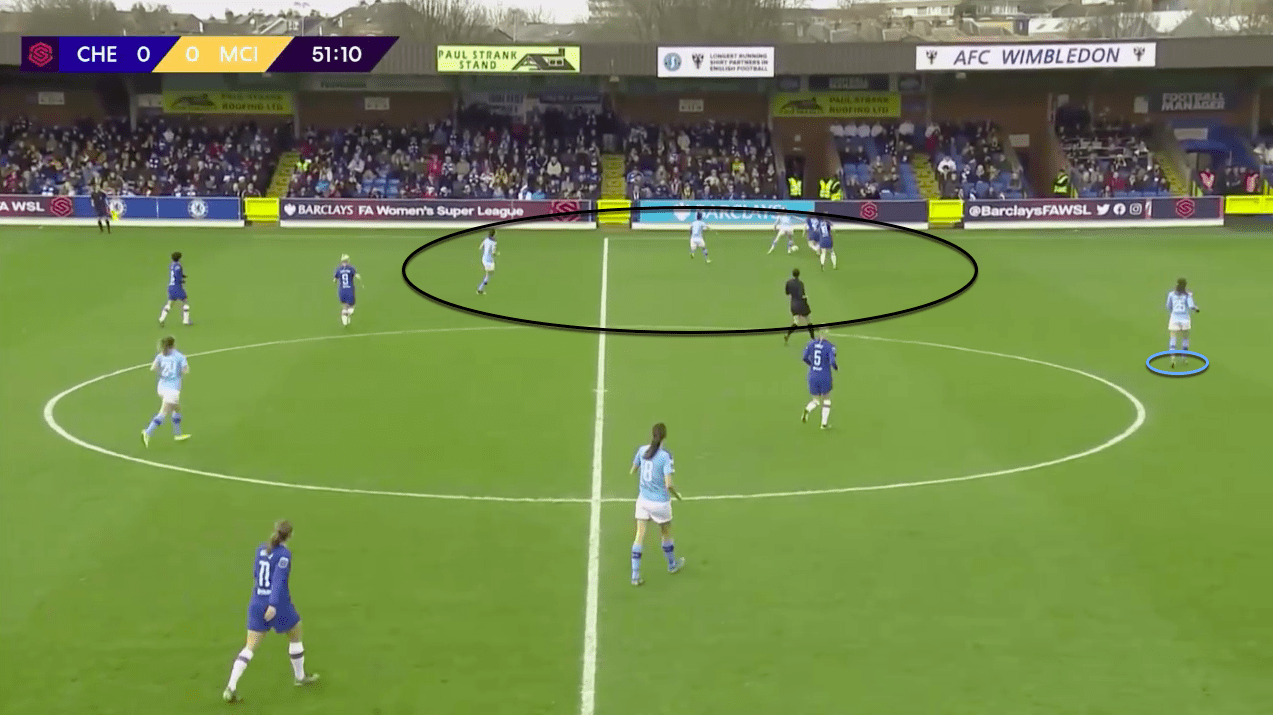
Immediately, Manchester City Women became much more dangerous than in the first half. Maren Mjelde was struggling to contain the City players, who were specifically looking to target her. In the images above and below, you can see examples of the space City were able to create on this side of the pitch in the second half. In the first image, you can see the amount of players City have pushed into advanced positions. Mjelde presses forward to stay on her attacker, Lauren Hemp. However, with the extra support on this side, Hemp can make a pass backwards before bolting down the line. Below you can see she has turned her defender and is available for a pass down the channel. In the middle of the pitch, support is unable to be provided due to Wullaert’s positioning. If the centre-half abandons her position, the Belgian winger has a free run into the front post for a chance to score.
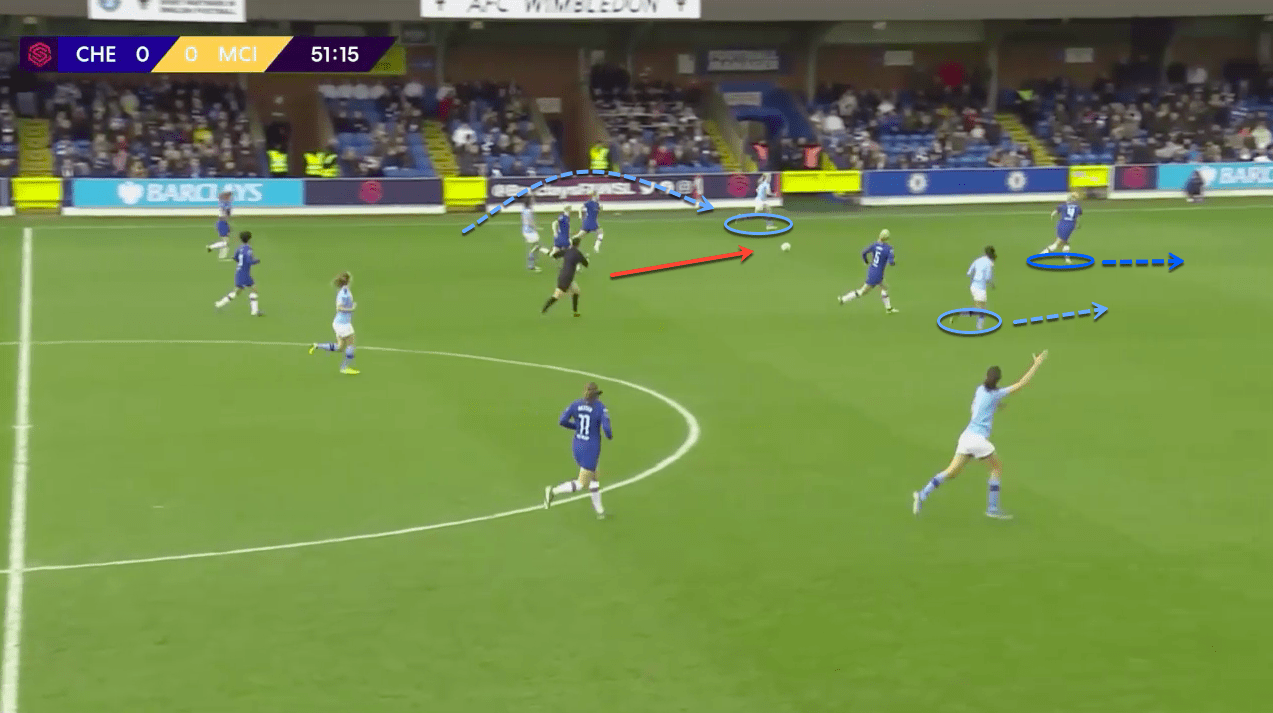
Chelsea Women’s pressure pays off
Chelsea Women will have been extremely frustrated after 70 minutes of the match. A few stunning saves from Roebuck along with Mjelde and Ji So-Yun hitting the woodwork would leave most sides start to lose hope trailing 1-0. Much like their match against Arsenal Women earlier this campaign, however, Hayes’ side has stuck to the tactics she sets them out in until the very end, confident that they will find a breakthrough.
Chelsea continued to work through their preferred structure to find a way through their opponents. In Hayes’ 4-4-2 formation, which was used for the most part in the second half as they went to try and win the match, they have specific patterns of play that are consistently successful.
Ji and Sophie Ingle drop deep to give options to the centre-halves in possession. To keep the forwards linked to the defensive players in this set-up, the wide midfielders are encouraged to move into more central areas. Below you can see an example of this. Cuthbert is occupying a central position as she looks to gain possession, with Ji and Ingle playing in deeper supporting roles.
When possession reaches this mark, Chelsea Women look for runners. Their preferred attacking outlet from here is the wings.
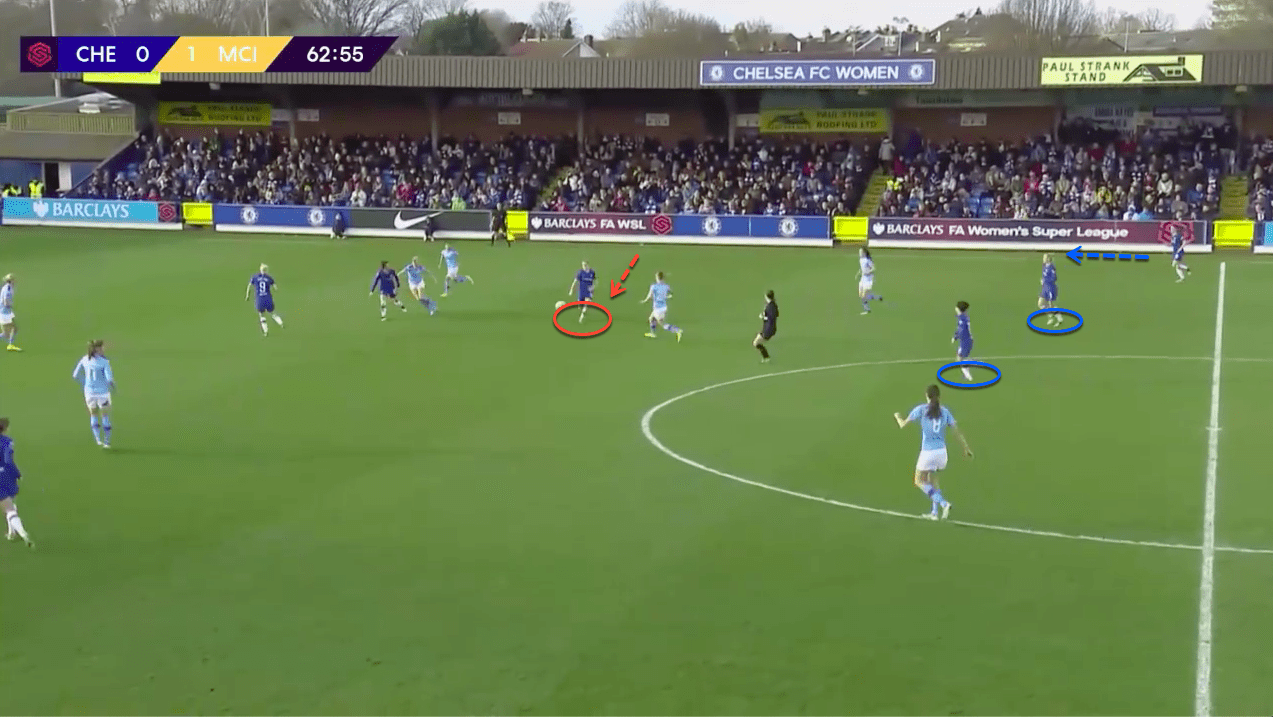
When possession is dropped back into Ingle in this example, Mjelde is using the open space down the wing to get forward. She is found with a forward pass into this space to get a cross into Chelsea’s very willing runners in the box.
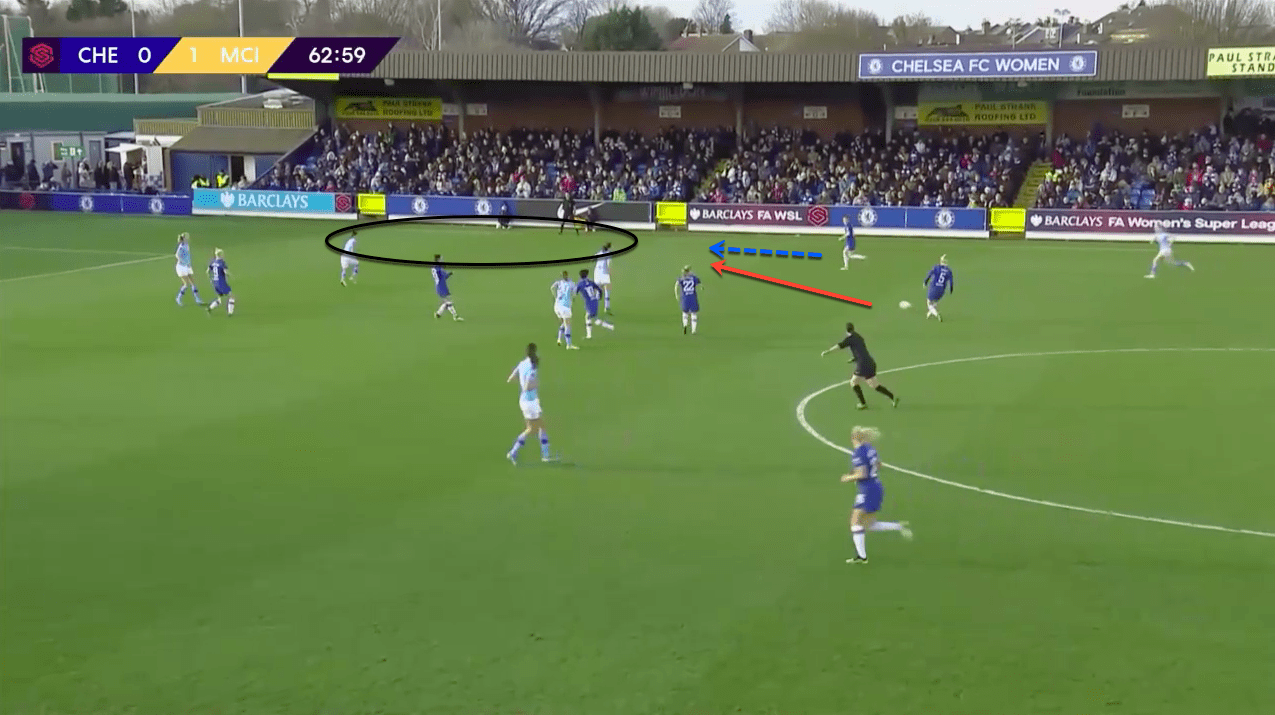
Chelsea’s commitment to their system paid off. While both goals came from set-pieces, these tactics were essential in creating the opportunities they were able to take. In the build-up to the game-winning goal, Mjelde was fouled as she pushed forward in open space down the right side. The resulting free-kick was not dealt with properly and Chelsea were able to capitalise.
England’s attacking prowess
England struggled last season to get into the team. Kirby was the first-choice in a side that played 4-2-3-1. However, she always impressed when given the opportunity. This season, the switch to a 4-4-2 in the beginning stages gave her a chance to cement a place in the starting side, and she has become the number one when Chelsea Women opt for a one-striker formation.
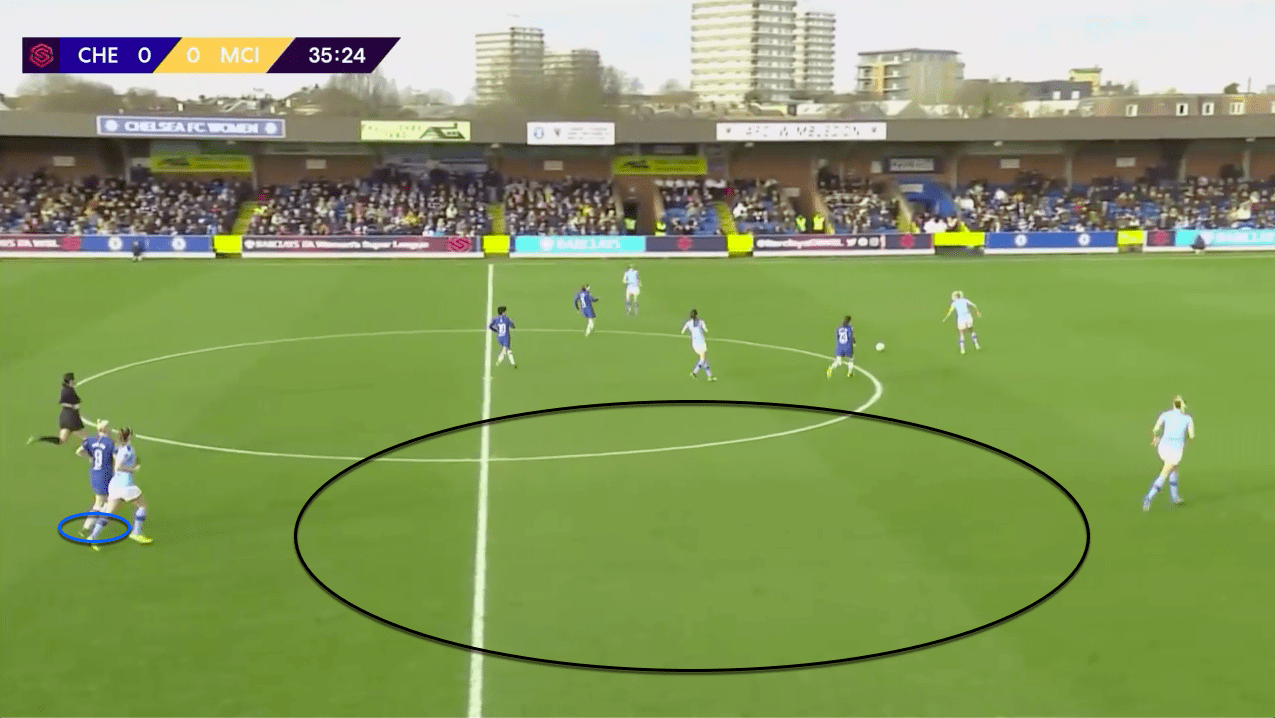
One of her biggest strengths is her anticipation. She can think two or three steps ahead of play as it goes on and position herself based off of that intuition to score her goals. Above you can see her in a deep position following a clearance from one of Chelsea’s defenders. As her teammates go to close the ball down, she waits and keeps an eye on the opening ahead of her. Once possession is won, she drives forward. She is found by her teammate, before beating a defender only to be thwarted by Roebuck on this occasion.
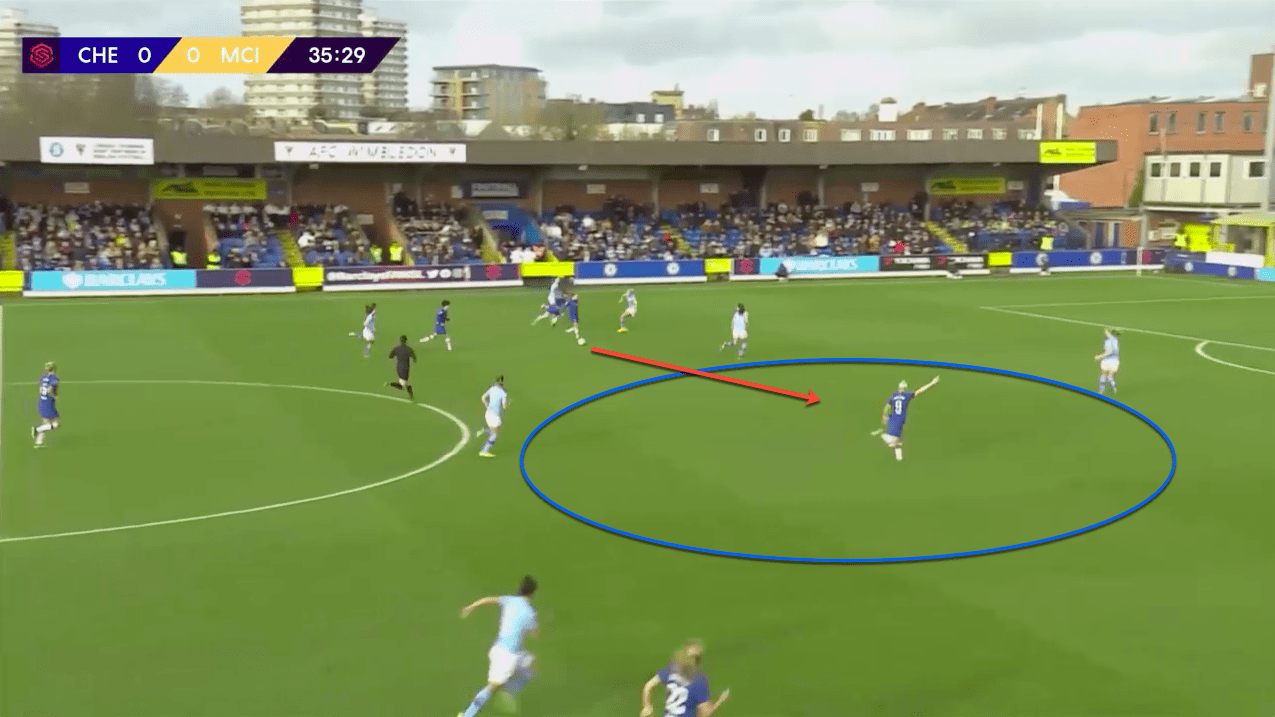
England was a constant threat throughout the match. In the end, she grabbed her goal using her quick reflexes on a rebound Roebuck conceded on an initial shot from outside the box. It will be interesting to see how Chelsea’s side change as we move forward, but England has made it very apparent this season she is essential to any title challenge.
Conclusion
As we move into the final week before the winter break, these two sides are trending in very different directions. Cushing’s Manchester City Women side are reeling, after an early Champions League exit and losses to each of their title rivals leaving them in a tough situation. The issue of translating the side’s attacking ability against the smaller teams in the league to these big matches will be the main focus over the remainder of the season. Injuries have played their part and a lot of players find themselves in unnatural positions. Manchester City will have to be just about perfect the rest of the way if they have any chance at winning the league title.
As for Chelsea Women, they are soaring. Even more impressive than their undefeated start to the season is the resiliency they have shown in the process. Coming from behind against both of their main rivals shows a belief in their tactics and teammates that is very unique. Looking ahead, as well, they can get even stronger. A return for the starting right-back will be a massive boost. Sam Kerr’s impending arrival at the beginning of January sends a major statement that they are looking to cement their place as the team to beat in the FAWSL. The NWSL’s standout striker will bring a unique skillset to London, and she makes Chelsea a major team to look out for in the new year.

If you love tactical analysis, then you’ll love the digital magazines from totalfootballanalysis.com – a guaranteed 100+ pages of pure tactical analysis covering topics from the Premier League, Serie A, La Liga, Bundesliga and many, many more. Buy your copy of the December issue for just ₤4.99 here






Comments